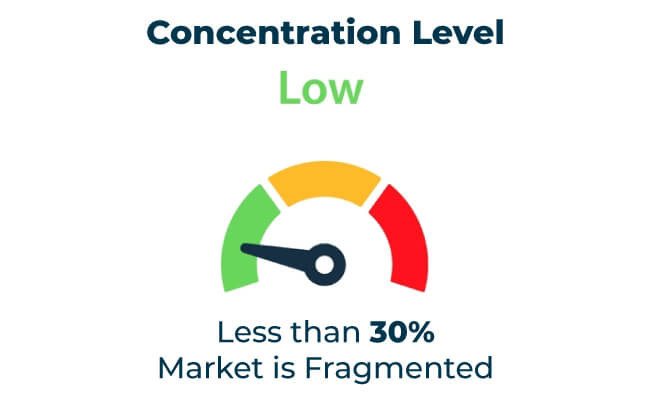The Rigid IBC (Intermediate Bulk Container) market is expanding steadily due to rising demand for efficient storage, transportation, and handling of bulk liquids and solids in industries such as chemicals, food & beverages, and pharmaceuticals.
Leading companies, including Mauser Group, SCHÜTZ, and Greif, are driving innovation with durable, reusable, and eco-friendly IBC designs. The market is projected to grow at a CAGR of 5.7%, reaching USD 35910.5 million by 2035. Emphasis on sustainability, cost-efficient operations, and increasing global trade propels this market forward.
| Attribute | Details |
|---|---|
| Projected Value by 2035 | USD 35910.5 million |
| CAGR (2025 to 2035) | 5.7% |
Exclusive Offer: 30% Off on Regional Reports
Get a free sample report and customize your regions for a 30% discount on your regional report!
Mauser Group excels in offering reusable and sustainable IBC solutions, SCHÜTZ leads with high-performance IBC designs with global pooling systems, and Greif innovates with lightweight and durable options tailored for various applications.
Weaknesses
High production costs for sustainable IBC materials challenge affordability. Competition from alternative packaging solutions, such as drums and flexible IBCs, limits market penetration in certain sectors.
| Category | Market Share (%) |
|---|---|
| Top 3 Players (Mauser Group, SCHÜTZ, Greif) | 15% |
| Rest of Top 5 Players | 08% |
| Next 5 of Top 10 Players | 05% |
Type of Player & Industry Share (%), 2025
| Player Tier | Industry Share (%) |
|---|---|
| Top 10 Players | 28% |
| Next 20 Players | 42% |
| Remaining Players | 30% |

Year-over-Year Leaders
Mauser Group drives sustainability with reusable IBC systems, SCHÜTZ innovates with high-performance pooling solutions, and Greif leads with eco-friendly, lightweight container designs.
Mauser Group pioneers durable, sustainable IBCs for efficient supply chain management. SCHÜTZ focuses on high-quality IBCs that meet global pooling standards. Greif specializes in lightweight, recyclable IBCs tailored for a wide range of industries.
The Rigid IBC market aligns with global sustainability goals by prioritizing recyclable materials and energy-efficient manufacturing practices.
Key Sustainability Phenomena
Check Free Sample Report & Save 40%!
Select your niche segments and personalize your insights for smart savings. Cut costs now!
North America enforces stringent safety and material standards for transporting hazardous goods. Europe leads with regulations promoting sustainable packaging and reusable systems. Asia-Pacific shows rapid growth in adopting sustainable IBCs, driven by industrial expansion and export activities.
Emerging markets in Asia-Pacific, Africa, and Latin America drive demand for durable and cost-effective IBCs, creating opportunities for manufacturers to expand globally.
High costs of sustainable materials and limited recycling infrastructure in certain regions restrict adoption. Additionally, competition from drums and flexible containers poses challenges.
The growth of food, beverage, and chemical industries in emerging markets creates significant demand for durable and sustainable IBC solutions. Smart IBC technologies provide opportunities for supply chain optimization.
This section evaluates the geographic dynamics shaping the caps and closure market. By analyzing key regions such as North America, Europe, Asia-Pacific, and other emerging markets, we gain insights into the drivers and market shares that define their contributions.
| Region | North America |
|---|---|
| Market Share (%) | 35% |
| Key Drivers | Demand for safety-compliant, reusable IBCs. |
| Region | Europe |
|---|---|
| Market Share (%) | 30% |
| Key Drivers | Sustainability mandates and advanced designs. |
| Region | Asia-Pacific |
|---|---|
| Market Share (%) | 25% |
| Key Drivers | Industrial growth and increasing exports. |
| Region | Other Regions |
|---|---|
| Market Share (%) | 10% |
| Key Drivers | Rising adoption of cost-efficient IBC solutions. |
The Rigid IBC market will grow as industries focus on sustainability, automation, and global trade. Companies investing in advanced materials, smart technologies, and emerging market opportunities will shape the future of this dynamic sector.
Mauser Group introduced scalable and reusable IBC systems, SCHÜTZ expanded its portfolio of pooling solutions, and Greif led with recyclable, lightweight IBC designs.
This classification categorizes vendors based on their influence and market presence, providing insights into their strengths and contributions to the market. Tier 1 companies, such as Mauser Group, SCHÜTZ, and Greif, lead with innovative and scalable solutions.
Tier 2 players, including Thielmann and Hoover CS, maintain strong regional operations. Tier 3 vendors, such as Snyder Industries and Bulk Handling Australia, focus on niche products and emerging opportunities.
| Tier | Key Companies |
|---|---|
| Tier 1 | Mauser Group, SCHÜTZ, Greif |
| Tier 2 | Thielmann, Hoover CS |
| Tier 3 | Snyder Industries, Bulk Handling Australia |
Mauser Group developed modular and reusable IBC solutions, SCHÜTZ focused on high-strength pooling systems, and Greif introduced IoT-enabled smart IBCs for real-time monitoring.
The Rigid IBC market is poised for steady growth as industries focus on sustainability, safety, and global trade. Companies investing in innovative designs, IoT-enabled solutions, and emerging market expansion will shape the future of this vital industry.
Key Definitions
Research Methodology
Primary research involved interviews with industry stakeholders, while secondary research included analysis of industry reports and market data. Findings were validated through expert opinions and triangulation.
Market Definition
The Rigid IBC market encompasses durable, reusable, and sustainable solutions designed for efficient storage and transportation in industries such as chemicals, food & beverages, and pharmaceuticals.
Increasing demand for sustainable, durable, and reusable containers for industrial applications.
The market is expected to grow at a CAGR of 5.7%, reaching USD 35910.5 million by 2035.
Mauser Group, SCHÜTZ, and Greif are among the top players.
The top 10 players hold approximately 85% of the global market share.
Asia-Pacific and Latin America show significant growth due to industrial expansion and export demands.
Explore Packaging Formats Insights
View Reports
Thank you!
You will receive an email from our Business Development Manager. Please be sure to check your SPAM/JUNK folder too.